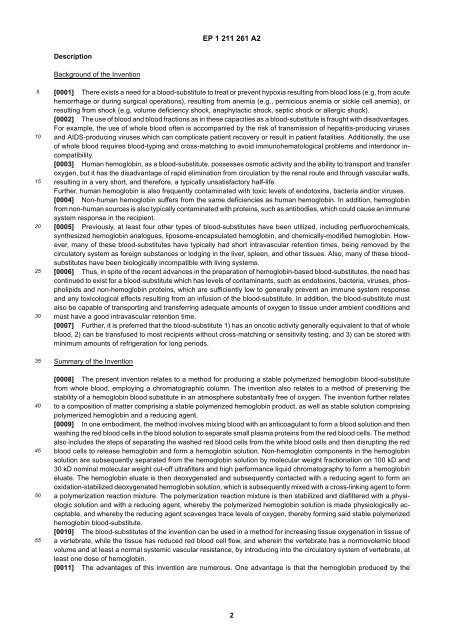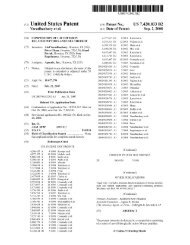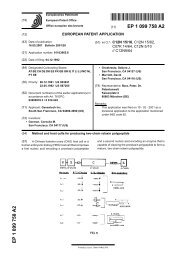EP 1 211 261 A2
EP 1 211 261 A2
EP 1 211 261 A2
You also want an ePaper? Increase the reach of your titles
YUMPU automatically turns print PDFs into web optimized ePapers that Google loves.
<strong>EP</strong> 1 <strong>211</strong> <strong>261</strong> <strong>A2</strong>DescriptionBackground of the Invention510152025303540455055[0001] There exists a need for a blood-substitute to treat or prevent hypoxia resulting from blood loss (e.g, from acutehemorrhage or during surgical operations), resulting from anemia (e.g., pernicious anemia or sickle cell anemia), orresulting from shock (e.g, volume deficiency shock, anaphylactic shock, septic shock or allergic shock).[0002] The use of blood and blood fractions as in these capacities as a blood-substitute is fraught with disadvantages.For example, the use of whole blood often is accompanied by the risk of transmission of hepatitis-producing virusesand AIDS-producing viruses which can complicate patient recovery or result in patient fatalities. Additionally, the useof whole blood requires blood-typing and cross-matching to avoid immunohematological problems and interdonor incompatibility.[0003] Human hemoglobin, as a blood-substitute, possesses osmotic activity and the ability to transport and transferoxygen, but it has the disadvantage of rapid elimination from circulation by the renal route and through vascular walls,resulting in a very short, and therefore, a typically unsatisfactory half-life.Further, human hemoglobin is also frequently contaminated with toxic levels of endotoxins, bacteria and/or viruses.[0004] Non-human hemoglobin suffers from the same deficiencies as human hemoglobin. In addition, hemoglobinfrom non-human sources is also typically contaminated with proteins, such as antibodies, which could cause an immunesystem response in the recipient.[0005] Previously, at least four other types of blood-substitutes have been utilized, including perfluorochemicals,synthesized hemoglobin analogues, liposome-encapsulated hemoglobin, and chemically-modified hemoglobin. However,many of these blood-substitutes have typically had short intravascular retention times, being removed by thecirculatory system as foreign substances or lodging in the liver, spleen, and other tissues. Also, many of these bloodsubstituteshave been biologically incompatible with living systems.[0006] Thus, in spite of the recent advances in the preparation of hemoglobin-based blood-substitutes, the need hascontinued to exist for a blood-substitute which has levels of contaminants, such as endotoxins, bacteria, viruses, phospholipidsand non-hemoglobin proteins, which are sufficiently low to generally prevent an immune system responseand any toxicological effects resulting from an infusion of the blood-substitute. In addition, the blood-substitute mustalso be capable of transporting and transferring adequate amounts of oxygen to tissue under ambient conditions andmust have a good intravascular retention time.[0007] Further, it is preferred that the blood-substitute 1) has an oncotic activity generally equivalent to that of wholeblood, 2) can be transfused to most recipients without cross-matching or sensitivity testing, and 3) can be stored withminimum amounts of refrigeration for long periods.Summary of the Invention[0008] The present invention relates to a method for producing a stable polymerized hemoglobin blood-substitutefrom whole blood, employing a chromatographic column. The invention also relates to a method of preserving thestability of a hemoglobin blood substitute in an atmosphere substantially free of oxygen. The invention further relatesto a composition of matter comprising a stable polymerized hemoglobin product, as well as stable solution comprisingpolymerized hemoglobin and a reducing agent.[0009] In one embodiment, the method involves mixing blood with an anticoagulant to form a blood solution and thenwashing the red blood cells in the blood solution to separate small plasma proteins from the red blood cells. The methodalso includes the steps of separating the washed red blood cells from the white blood cells and then disrupting the redblood cells to release hemoglobin and form a hemoglobin solution. Non-hemoglobin components in the hemoglobinsolution are subsequently separated from the hemoglobin solution by molecular weight fractionation on 100 kD and30 kD nominal molecular weight cut-off ultrafilters and high performance liquid chromatography to form a hemoglobineluate. The hemoglobin eluate is then deoxygenated and subsequently contacted with a reducing agent to form anoxidation-stabilized deoxygenated hemoglobin solution, which is subsequently mixed with a cross-linking agent to forma polymerization reaction mixture. The polymerization reaction mixture is then stabilized and diafiltered with a physiologicsolution and with a reducing agent, whereby the polymerized hemoglobin solution is made physiologically acceptable,and whereby the reducing agent scavenges trace levels of oxygen, thereby forming said stable polymerizedhemoglobin blood-substitute.[0010] The blood-substitutes of the invention can be used in a method for increasing tissue oxygenation in tissue ofa vertebrate, while the tissue has reduced red blood cell flow, and wherein the vertebrate has a normovolemic bloodvolume and at least a normal systemic vascular resistance, by introducing into the circulatory system of vertebrate, atleast one dose of hemoglobin.[0011] The advantages of this invention are numerous. One advantage is that the hemoglobin produced by the2




